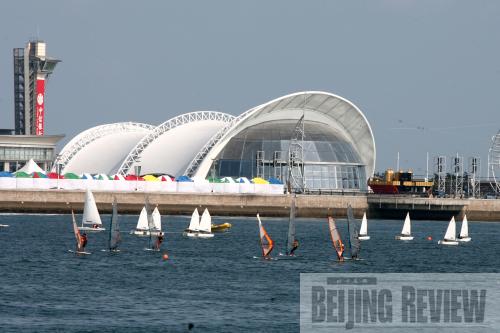|
 |
|
ONE MORE LANDMARK: The newly built theater at Qingdao Olympic Sailing Center in Shandong Province, seen here on August 1, 2009, has become another tourist attraction in China (CFP) |
And amazing as both venues are, they are but two of the 31 Beijing-based structures that were designed and constructed through the sheer tenacity and creativity of the people of China.
New venues included the National Indoor Stadium, the Laoshan Velodrome, the Beijing Olympic Basketball Gymnasium, the Shunyi Olympic Rowing-Canoeing Park and over half a dozen more.
The upgrading of almost a dozen existing venues and the building of eight temporary sites such as the triathlon and road-cycling courses complemented these stunning new assets.
The IOC imprimatur
The high standard set by the Beijing venues was something not lost on International Olympic Committee President Jacques Rogge.
On a final inspection prior to the Games, Rogge said he was deeply impressed with the "beautiful" venues.
"They are the best I have ever seen," he said.
Only months later, at the press conference following the closing ceremony, he declared the venues "unprecedented."
Rogge said the venues and facilities would leave a rich legacy for the host city." These are sports venues that have been built and have been very intelligently embedded into the universities for the most part. And the after-the-Games use of the venues will be optimal," the president said.
"These venues will be used on a day-to-day basis by students, property owners, workers' unions. This is, I believe, a great legacy," he said.
The Long-term benefits
President Rogge's comments bring us to the long-term economic benefits of the Olympic legacy.
What many people possibly don't realize is that the Olympic venues of host cities past have, by their very existence, encouraged lucrative repeat sports tourism to those cities.
The Olympic cities have proven their ability to host major sporting and cultural events and they have shown they are capable of staging world and national championships, football competitions, aquatics, track and field and events of a similar caliber.
When the cauldron is extinguished and the athletes of the world head home, the infrastructure remains and that Olympic city becomes a magnet for other sports and cultural events of all kinds.
As Beijing organizing committee official Jiang Xiaoyu wrote in the state media recently, "Beijing has made some initial achievements in the proper use of sport venues to meet people's needs."
"The Olympic Green has become a new popular tourist spot. The number of visitors these venues drew exceeded even that of the Forbidden City for some time after the Games," Jiang said.
One needs look no further than the Chaoyang Park Stadium, where Olympic medals were decided in beach volleyball last August.
It is now the Sun Beach Theme Park, filled with families playing in the sand and taking in the unique atmosphere.
| 